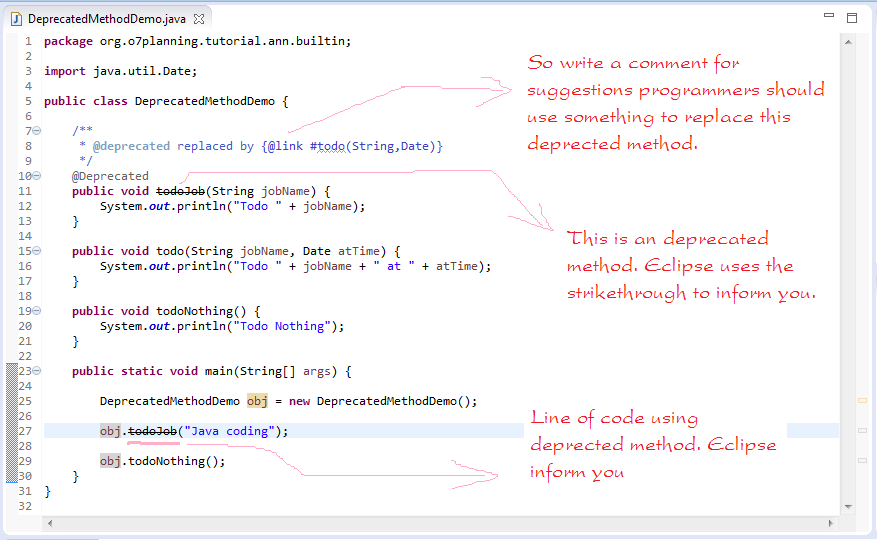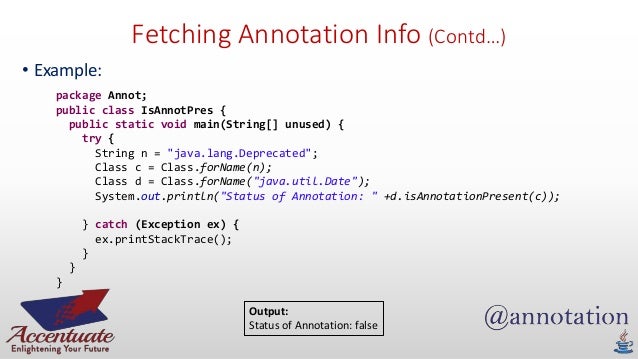
Annotation formats
Java Custom annotations or Java User-defined annotations are easy to create and use. The @interface element is used to declare an annotation. For example: @interface MyAnnotation {} Here, MyAnnotation is the custom annotation name. Points to remember for java custom annotation signature · Method 2: Custom annotations; Focusing onto custom annotations for which in order to use your custom annotation, we simply need to call your annotation using your annotation Name preceded with @symbol and pass the value of the declared variables in an ordered manner to the variables that you have declared in the annotation. Example 1 A single element annotation contains only one element. Its syntax is: @AnnotationName (elementName = "elementValue") If there is only one element, it is a convention to name that element as value. @AnnotationName (value = "elementValue") In this case, the element name can be excluded as well. The element name will be value by default

Built-In Java Annotations
Then the solution was an introduction to Annotations. Don't get confused with the fact that we should always prefer loose coupling as it differs in case of Annotations. You will feel the benefits almost always when you completely understand the topic 'Annotations In Java'. Just using an annotation instead of creating · The first step to creating a custom annotation is to declare it using the @interface keyword: public @interface GFG { } The next step is to specify the scope and the target of our custom annotation Java Custom annotations or Java User-defined annotations are easy to create and use. The @interface element is used to declare an annotation. For example: @interface MyAnnotation {} Here, MyAnnotation is the custom annotation name. Points to remember for java custom annotation signature

Table of Contents
· Method 2: Custom annotations; Focusing onto custom annotations for which in order to use your custom annotation, we simply need to call your annotation using your annotation Name preceded with @symbol and pass the value of the declared variables in an ordered manner to the variables that you have declared in the annotation. Example 1 · You can get your method’s annotation by using this snippet: Annotation annotation = blogger.comhod().getConstructorOrMethod().getMethod().getAnnotation(blogger.com) Then you can transform this generic Annotation object to any of your custom annotations A single element annotation contains only one element. Its syntax is: @AnnotationName (elementName = "elementValue") If there is only one element, it is a convention to name that element as value. @AnnotationName (value = "elementValue") In this case, the element name can be excluded as well. The element name will be value by default

Built-In Java Annotations used in Java code
· You can get your method’s annotation by using this snippet: Annotation annotation = blogger.comhod().getConstructorOrMethod().getMethod().getAnnotation(blogger.com) Then you can transform this generic Annotation object to any of your custom annotations · First you need to mark if annotation is for class, field or method. Let's say it is for method: so you write this in your annotation definition: @Target (blogger.com) @Retention (blogger.comE) public @interface DirtyCheck { String newValue (); String oldValue (); }Reviews: 3 How Are Annotations Created? For our JSON serializer, we will create a field annotation that allows a developer to mark a field to be included when serializing an object. For example, if

Your Answer
· The first step to creating a custom annotation is to declare it using the @interface keyword: public @interface GFG { } The next step is to specify the scope and the target of our custom annotation · Method 2: Custom annotations; Focusing onto custom annotations for which in order to use your custom annotation, we simply need to call your annotation using your annotation Name preceded with @symbol and pass the value of the declared variables in an ordered manner to the variables that you have declared in the annotation. Example 1 · �� To define any custom annotation, we first need to declare it using an @interface tag. Then we define the target and scope using meta annotations. I have explained the use of the meta annotations Author: Utkarsh Jain
No comments:
Post a Comment